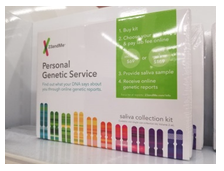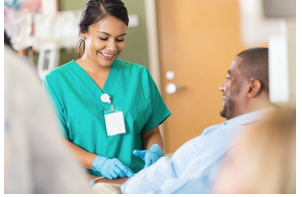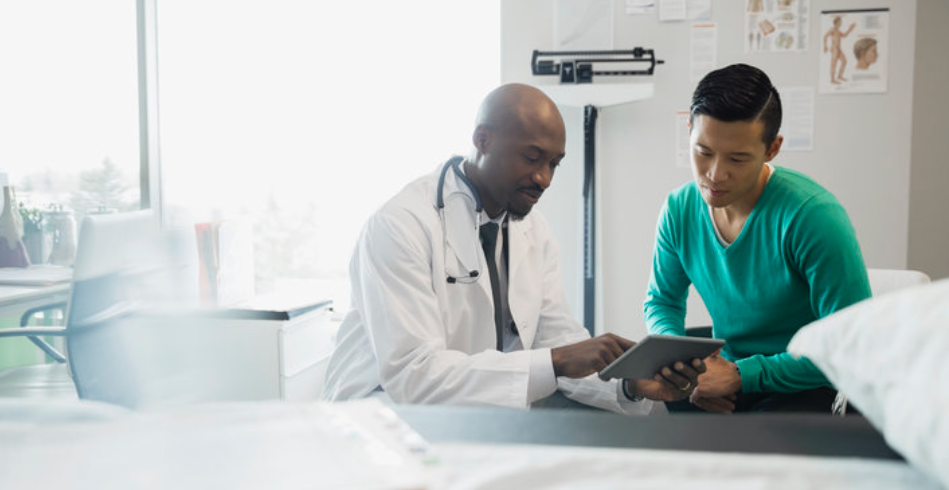WELLNESS--When it comes to treating cancer, early detection can be beneficial. That’s why experts are constantly working to develop new technology that catches the disease or pinpoints your risk level as soon as possible.
“Cancer screening leads to early detection of cancer, allowing most cancers to be diagnosed at a stage that is curable,” said Lauren Nye, an oncologist at the University of Kansas Medical Center.
These are the important tests you should be aware of when it comes to early detection of cancer.
But navigating this process can be confusing, to say the least. What cancer diagnostic tests or tests for risk level should you have done and at what age? And how reliable are these tests? Below, experts break down the important tests you should be aware of when it comes to early cancer risk detection and when (or if!) you should consider taking them:
At-Home Genetic Testing
 Some at-home genetic tests can also offer health results. Within 23andMe’s health and ancestry service, customers can opt in to accessing their risk for the select variants of the BRCA1 or BRCA2 gene through a report. The report, authorized by the Food and Drug Administration, provides information on whether a person’s genetic result is associated with an increased risk for breast, ovarian, prostate and other cancers.
Some at-home genetic tests can also offer health results. Within 23andMe’s health and ancestry service, customers can opt in to accessing their risk for the select variants of the BRCA1 or BRCA2 gene through a report. The report, authorized by the Food and Drug Administration, provides information on whether a person’s genetic result is associated with an increased risk for breast, ovarian, prostate and other cancers.
Stacey Detweiler, a medical affairs associate and genetic counselor with 23andMe, said it’s important to note that 23andMe “only tests for three of more than 1,000 BRCA variants known to increase cancer risk.”
And a negative result in the report ― i.e., “no variants detected” ― does not mean the user isn’t at risk for cancer because other genetic and nongenetic factors that are not tested still play a large role in overall risk for these cancers, Detweiler added. But a positive result ― or “variant detected”― may indicate a person’s risk for certain cancers, especially breast and ovarian cancer in women.
“We strongly recommend customers whose genetic result is associated with an increased cancer risk to speak to a health care professional about additional testing to confirm the result and to better understand their potential cancer risks,” Detweiler said.
A warning to keep in mind: Some experts caution against at-home genetic health testing if you experience anxiety. It’s a personal decision that’s best weighed against factors including your mental health and your genetic risk for cancer.
3D Mammograms
“Until there is a cure, screening mammography is our best tool in the fight against breast cancer,” said Michael Fishman, a radiologist at Boston Medical Center. For early detection, Fishman suggested breast cancer screenings with tomosynthesis (i.e., a 3D mammogram).
Breast tomosynthesis takes a series of images of the breast that can be scrolled through, similar to the pages of a book, so radiologists can examine the breast layer by layer. This, according to Fishman, provides radiologists with clearer, more accurate images and allows them to identify cancers that may be hidden in breast tissue. Fishman recommends mammography screenings at age 40 and annually thereafter.
“Some women, depending on their personal breast history, their family history and their genetics, may need to begin screening at a younger age,” noted Lauren Carcas, a medical oncologist and breast cancer specialist at the Miami Cancer Institute. Chat with your doctor about your risk factors to figure out when you may need to start.
Colonoscopies
David Liska, a colorectal surgeon at Cleveland Clinic, said colon cancer is one of the most preventable cancers and the ideal tool to screen for it is a colonoscopy.
“A colonoscopy is the only colorectal cancer screening test that can prevent cancer, while other tests just detect cancer. A colonoscopy can both detect and remove polyps before they can turn into colon cancer,” he said, adding that the majority of people may have no symptoms from colorectal cancer at its earliest stage, which is why it is essential to keep up with screenings.
The American Cancer Society recommends people at an average risk for colorectal cancer start regular screenings at age 45.
Stool Tests For Colon Cancer
While colonoscopies are the preferred method for colon cancer screenings, there are other tests that have been approved as well, which can be done from your own bathroom.
High-sensitivity fecal occult blood tests (FOBT) check for the appearance of blood in the stools that are unable to be seen visually. For these tests, which are approved by the FDA as a form of colorectal cancer screening, patients collect stool samples and return them to their doctor for analysis.
Cologuard is another FDA-approved, noninvasive stool screening that can be done for those 50 years or older and with an average risk for colon cancer. Patients can get access to Cologuard by discussing their screening options with their health care provider, who can then prescribe it. The testing kit is sent with simple instructions to follow, according to Mark Stenhouse, president of Cologuard at Exact Sciences.
“Patients provide a stool sample and ship it in the original prepaid box back to the lab. Results are sent to their health care provider within two weeks,” Stenhouse said.
If the test is positive, the patient will be referred for a diagnostic colonoscopy for additional testing. Stenhouse added that Cologuard is intended for those age 50 and older. The advantages of these tests is that they require no cleansing of the colon and do not involve a patient having to take time off work and to undergo sedation, unless a test result comes back and a doctor deems a colonoscopy necessary.
Blood Tests
 There are several blood tests a doctor may perform to assess your risk of cancer.
There are several blood tests a doctor may perform to assess your risk of cancer.
For example, CellMax Life FirstSight test is a blood test for colorectal cancer screening for the presence of pre-cancer or colorectal cancer.
“This test is for the routine screening of individuals 45 years or older and with average risk for colorectal cancer, meaning they do not have a genetic predisposition or a personal or family history of colorectal cancer,” said Mana Javey, the medical director at CellMax Life. Javey added that individuals with a positive result should get a diagnostic colonoscopy as the confirmatory test.
One of the best ways to test for prostate cancer ― one of the most common cancers in men ― is also through a blood test, called a prostate-specific antigen (PSA) blood test. This measures the level of a protein made by cells in the prostate gland in the blood. A rise indicates there may be an issue with the prostate.
“Studies show that a prostate-specific antigen (PSA) test done early — in a man aged 40 to 45 — will assess his risk of developing lethal prostate cancer,” said Behfar Ehdaie, a urologist with Memorial Sloan Kettering Cancer Center.
This test will classify a patient into one of three groups: a low-risk group (where the individual doesn’t need PSA testing for another five years or so), an intermediate-risk group (where the person should get PSA testing in another year or two) and a high-risk group (where the individual should be evaluated more closely right away), Ehdaie explained.
Pap Smears And HPV Tests For Cervical Cancer
Jessica Shepherd, an OB-GYN and gynecological surgeon at Baylor University Medical Center in Texas, said Pap smears and a test for the human papillomavirus are the best screenings available for cervical cancer.
“Cervical cancer was once the No. 1 cancer killer among American women, but the cervical cancer death rate has dropped significantly since the introduction of the Pap test more than 70 years ago,” she said.
This is why HPV testing is important too, which can be included when you get a Pap smear. Certain forms of HPV can cause cervical cancer and roughly 8 out of 10 U.S. women will contract HPV at some point in their lives. “Most HPV infections go away on their own. Those that persist can eventually develop into cancer,” she said, adding that cervical cancer testing offers early detection of abnormalities before they become cancer.
Shepherd said women should be screened for cervical cancer starting at age 21 until age 65 and that women ages 21 to 29 should get tested with the Pap test. For women ages 30 to 65, it’s recommended to be screened with both a Pap smear and the HPV test together, she added. This is the preferred standard for this age group and detects 95 percent of cervical cancer cases.
Mole Mapping For Skin Cancer
Mole mapping is a tool being used in select hospitals and clinics that does a full-body scan of the skin in individuals at high risk of developing melanoma, according to Burton Eisenberg, executive medical director of Hoag Family Cancer Institute in Newport Beach, California.
“The tool takes a series of computer-enhanced photos of your body, evaluating pigmented skin lesions for risk. And every six months to one year the patient returns and a repeat scan is then used to compare if changes occurred during the interval since the last visit,” he said.
Jenny Sobera, a dermatologist and chief medical officer at Face MD Plus, recommends the procedure for patients with numerous, atypical-looking moles. “Because skin cancer is often detected when a mole has changed, mapping may be the only way to distinguish a changing mole from other stable moles in the same general area,” she said.
Professional Checkups
Sometimes an annual physical can be the earliest point of entry. This might be a time your doctor can catch early signs of a health issue, like cancer, and may refer you for additional testing if they notice anything they’d like to have investigated.
The same goes for yearly specialist appointments, like the dermatologist, where a medical professional might examine your moles for any signs of skin cancer. It’s a procedure that should be performed once yearly for all patients over 35 and those that have risk factors like fair skin, history of sunburn, history of tanning bed use and family history of skin cancer, Sobera said.
Additionally, “patients that have had skin cancer or pre-cancerous moles should have skin exams annually and in some cases every three to six months,” she added. “Dermatologists are highly trained in early detection and often use dermoscopy to look for subtle changes.”
Self-exams
Finally, don’t underestimate your own power. While many screenings or checks are administered by your doctor ― who recommends tests based on your age, family history and lifestyle ― there are measures you can take at home to make sure you’re in optimal health. This includes performing self-checks for physical signs of certain cancers, like breast cancer or skin cancer.
According to the Skin Cancer Foundation, everyone should perform a monthly head-to-toe self-examination of their skin to check for “any new or changing lesions that might be cancerous or precancerous.” The warning signs that a mole may be dangerous include a mole that changes color, increases in size, has an irregular outline or is larger than the size of a pencil eraser. A self-exam should take no more than 10 minutes and is something experts coin “a small investment in what could be a life-saving procedure.”
For breast self-exams, perform them once a month at home either in your shower, in front of a mirror or while lying in bed. Observe any lumps, changes or discharge. Keep note of any abnormalities in your breasts that you experience and report them to your doctor if anything seems different.
(Nicole Pajer writes for HuffPost … where this piece originated.)
-cw















